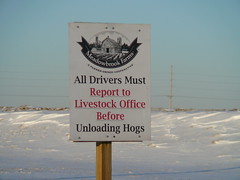Two things really caught my eye in the industry report. First, they use cutting edge information technology to track each hog carcass.
The tracking system incorporates electronic tag smart cards placed on each meathook. These electronic tags contain information about what farm the hog came from, how it was raised, what it was fed and what medications it received, information that is particularly sensitive to customers from Japan and Europe.Nevertheless, the logo for Meadowbrook Farms (formerly known as "American Heritage Farms") evokes "simpler times" with an image of a traditional midwestern barn and silo set amidst a furrowed field: high-tech, down-home. You CAN have it all! This reminds me of Ruth Ozeki's wonderful novel My Year of Meats, in which a Japanese American journalist is hired by the American Beef Exporters to produce a TV show for Japanese audience that will convince them to eat beef like Americans.
The second thing that caught my eye about this plant is that it is owned by a producers cooperative, and is branded as a "farmer coop." For each $900 share of the coop a member is entitled to have 50 hogs slaughtered per year. Sounds very egalitarian, but note that members range from 200 head slaughtered per year (4 shares or $3,600 investment) to 50,000 head per year (1,000 shares or $900,000 investment). Obviously, like many other agricultural enterprises (e.g., Sun Kist) this is a cooperative in name only. Don't get me wrong. I can see that this is likely a better deal for the farmers than selling to Cargill or Swift. And I have no reason to doubt that the product is high quality. But when you are sending 50,000 hogs to slaughter each year are you really a "farmer"?
~~~~~~~~~~~~~~~~
I was on the road again this week, out in the western suburbs of Chicago for the Sheetmetal Workers Industrial Association apprenticeship program. This was a 100% male group, with fewer of the older "second-career workers" we see in the IBEW. More like high school seniors than early college. The Transnational Capital Auction worked like a charm, but we really could have used more time to break through their youthful resistance to authority. We made an impact on a about a third of the class, I would guess based on the number of students who hung around asking questions afterward. And given the setup, I guess we can be happy with that.


No comments:
Post a Comment